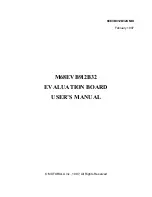
GENERAL INFORMATION
68EVB912B32UM/D
1-5
NOTES
The D-Bug12 operating instructions in this manual presume the
factory-default memory configuration. Other configurations
require different operating-software arrangements.
EEPROM resides in two areas of memory (refer to Table 3-5),
which are referred to in this manual as "byte-erasable EEPROM"
and "Flash EEPROM." This distinction is necessary because of the
different ways in which they may be programmed and used.
D-Bug12 uses the MCU’s Serial Communications Interface (SCI) for communications with the
user terminal. For information on the port and its connector, refer to 2.4 EVB to Terminal
Connection and 4.4 Terminal Interface.
If the MCU’s single-wire Background Debug Mode (BDM) interface serves as the user interface,
the SCI port becomes available for user applications. This mode requires either:
•
another M68EVB912B32 and a host computer
•
a background debug development tool, such as Motorola’s Serial Debug Interface
(SDI)
For more information, refer to the Motorola Serial Debug Interface User’s Manual.
Two methods may be used to generate EVB user code:
1. For small programs or subroutines, D-Bug12’s single-line assembler/disassembler
may be used to place object code directly into the EVB’s RAM or EEPROM.
2. For larger programs, P&E Microcomputer Systems' IASM12 or Motorola's MCUasm
assembler may be used on a host computer to generate S-Record object files, which
can then be loaded into the EVB’s memory using D-Bug12’s LOAD command.
The EVB features a prototype area, which allows custom interfacing with the MCU’s I/O and bus
lines. These connections are broken out via headers P2, P3, P4, and P6, which are immediately
adjacent to the MCU on the board. Wire-wrap pins may be placed in these headers to connect to
the prototyping area, as shown in Figure 1-1.
An on-board push-button switch, S1, provides for resetting the EVB hardware and restarting
D-Bug12.
The EVB can begin operation in any of four jumper-selectable (W3, W4) modes at reset:
1. In
EVB mode, program execution begins in one of two ways:
a. If D-Bug12 is resident in Flash EEPROM (i.e., if Mode 4 below has not been
performed), D-Bug12 immediately issues its command prompt on the terminal display
and waits for a user entry.
Summary of Contents for M68EVB912B32
Page 8: ...CONTENTS 68EVB912B32UM D viii ...
Page 11: ...GENERAL INFORMATION 68EVB912B32UM D 1 3 Figure 1 1 EVB Layout and Component Placement ...
Page 22: ...CONFIGURATION AND SETUP 68EVB912B32UM D 2 6 ...
Page 80: ...OPERATION 68EVB912B32UM D 3 58 ...
Page 90: ...HARDWARE REFERENCE 68EVB912B32UM D 4 10 ...
Page 102: ...COMMUNICATIONS PROGRAM EXAMPLES 68EVB912B32UM D B 8 ...
Page 106: ...D BUG12 STARTUP CODE 68EVB912B32UM D C 4 ...
Page 112: ...D BUG12 CUSTOMIZATION DATA 68EVB912B32UM D D 6 ...
Page 122: ...INDEX 68EVB912B32UM D 4 ...














































